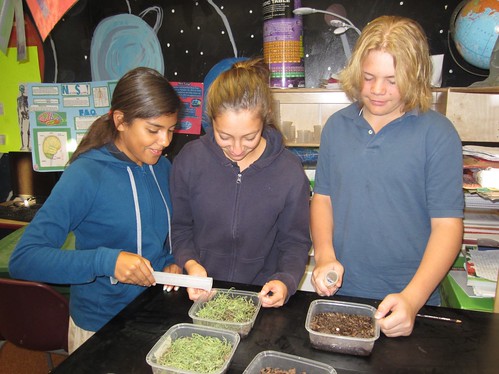
Students participate in a “Climate Change and the Water Cycle” module exercise. Photo from the Asombro Institute for Science Education home of the Chihuahuan Desert Nature Park
All this month we will be taking a look at what a changing climate means to Agriculture. The ten regional USDA Climate Hubs were established to synthesize and translate climate science and research into easily understood products and tools that land managers can use to make climate-informed decisions. The Hubs work at the regional level with an extensive network of trusted USDA agency partners, technical service providers, University collaborators, and private sector advisers to ensure they have the information they need to respond to producers that are dealing with the effects of a variable climate. USDA’s Climate Hubs are part of our broad commitment to developing the next generation of climate solutions, so that our agricultural leaders have the modern technologies and tools they need to adapt and succeed in the face of a changing climate.
USDA has created a curriculum for teaching today’s students about climate change and educating tomorrow’s farmers, ranchers, and decision makers. The Department’s Southwest Regional Climate Hub has partnered with the Asombro Institute for Science education to build “Climate Change and the Water Cycle,” a scientifically rigorous education unit for 6th -12th grade students. Intended for both formal and informal educators, the unit includes 9 activities which can either stand alone or be taught over 10 instruction hours. These hands-on activities are designed to help the students understand the scientific concepts behind different elements of the water cycle, climate change, and how to analyze data and communicate results. Here’s a list of the activities:
- Insulating You, Insulating Earth – Students model the enhanced greenhouse effect using their own body heat, space blankets and towels.
- Weather or Climate? You decide – Students use their understanding of the definitions of weather and climate to identify which of the two concepts is better represented by several figures that are presented during the activity.
- Understanding the difference – Students read a short article and examine reports from the popular media to find out if the American public and media understand the difference between weather and climate.
- Evaporation Investigation – Students conduct an experiment to investigate the effects of different environmental factors on the rate of evaporation.
- The Water Cycle Game – This has the students playing the roles of reservoirs and hydrologic processes to illustrate the movement of water in the water cycle.
- Streams and Steam – This is a board game based on Chutes and Ladders. The game demonstrates the effects of climate change on the water cycle.
- Ready, Set, Grow! – Students play the roles of water-intensive and drought-tolerant plants to understand the impacts of climate change on water, primary producers, and the food web.
- Rainout Shelters – This activity uses data from an actual field experiment that was designed to explore the effects of excluding moisture from desert plant communities; students analyze the data to find out how water availability affects plant growth.
- Climate Data Jam – In a data jam, students analyze and then showcase climate data by developing a creative project to communicate data trends to nonscientists.
The activities align with Common Core State Standards and Next Generation Science Standards. The Southwest Regional Climate Hub asked educators to review them for educational practices and scientists to review for scientific accuracy. Activities were pilot tested among 524 middle and high school students in New Mexico, and outcomes were assessed with pre- and post-tests. One student commented, “I loved all of the activities! They are fun and help us understand about what goes on in the world.” Educators who participated in pilot testing said, “the entire curriculum is great, but I was particularly impressed with the progression of ideas and the variety of lessons,” and “students could see the relevance and importance of these real life issues.”
The downloadable instruction manual with links to PowerPoint presentations and videos and printable student worksheets is easily accessible. The materials are currently being translated into Spanish. The second unit of the series entitled, Climate Change and Threats to Agriculture, is in the works and is expected to be completed near the end of 2016.
No comments:
Post a Comment
Note: Only a member of this blog may post a comment.